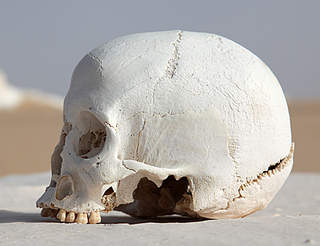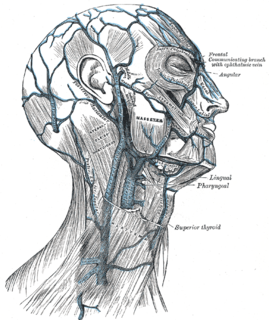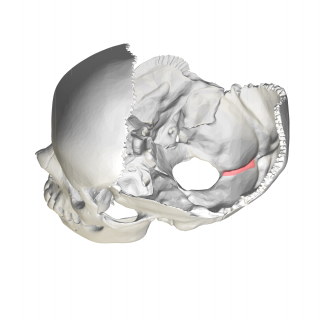
The occipital bone is a cranial dermal bone and the main bone of the occiput. It is trapezoidal in shape and curved on itself like a shallow dish. The occipital bone overlies the occipital lobes of the cerebrum. At the base of skull in the occipital bone, there is a large oval opening called the foramen magnum, which allows the passage of the spinal cord.

The obliquus capitis superior muscle is a small muscle in the upper back part of the neck and is one of the suboccipital muscles and part of the suboccipital triangle. It arises from the lateral mass of the atlas bone. It passes superiorly and posteriorly to insert into the lateral half of the inferior nuchal line on the external surface of the occipital bone. The muscle is innervated by the suboccipital nerve, the dorsal ramus of the first spinal nerve.

The occipitalis muscle is a muscle which covers parts of the skull. Some sources consider the occipital muscle to be a distinct muscle. However, Terminologia Anatomica currently classifies it as part of the occipitofrontalis muscle along with the frontalis muscle.

The epicranial aponeurosis is an aponeurosis which covers the upper part of the cranium in humans and various other animals. In humans, it is attached in the interval between its union with the occipitofrontalis muscle, to the external occipital protuberance and highest nuchal lines of the occipital bone; in front, it forms a short and narrow prolongation between its union with the frontalis muscle or frontal part of the occipitofrontalis muscle.

The occipitofrontalis muscle is a muscle which covers parts of the skull. It consists of two parts or bellies: The occipital belly, near the occipital bone, and the frontal belly, near the frontal bone. In humans, the occipitofrontalis only serves for facial expressions.

Galesaurus was a prehistoric carnivorous therapsid that lived between the Induan and the Olenekian age in what is now South Africa. It was incorrectly classified as a dinosaur by Sir Richard Owen in 1859.

The erector spinae or spinal erectors is a set of muscles that straighten and rotate the back.

The nuchal ligament is a ligament at the back of the neck that is continuous with the supraspinous ligament.

The posterior triangle is a region of the neck.

The nuchal lines are four curved lines on the external surface of the occipital bone:

The occipital vein begins as a plexus at the posterior aspect of the scalp from the external occipital protuberance and superior nuchal line to the back part of the vertex of the skull.

The squamous part of occipital bone, is situated above and behind the foramen magnum, and is curved from above downward and from side to side.

In the occipital bone, the lower division of the cruciate eminence is prominent, and is named the internal occipital crest; it bifurcates near the foramen magnum and gives attachment to the falx cerebelli; in the attached margin of this falx is the occipital sinus, which is sometimes duplicated.

Near the middle of the squamous part of occipital bone is the external occipital protuberance, the highest point of which is referred to as the inion. The inion is the most prominent projection of the protuberance which is located at the posterioinferior part of the human skull. The nuchal ligament and trapezius muscle attach to it.

The posterior auricular nerve arises from the facial nerve close to the stylomastoid foramen and runs upward in front of the mastoid process; here it is joined by a filament from the auricular branch of the vagus and communicates with the posterior branch of the great auricular as well as with the lesser occipital.

The Investing layer of deep cervical fascia is the most superficial part of the deep cervical fascia, and it encloses the whole neck.

The Ndutu skull is the partial cranium of a hominin that has been assigned variously to late Homo erectusHomo rhodesiensis, and early Homo sapiens, from the Middle Pleistocene, found at Lake Ndutu in northern Tanzania.
Occipital crest may refer to:
Zarhinocetus is an extinct genus of whale from the Early to Middle Miocene of the eastern North Pacific.
The nuchal crest in cephalopods is a prominent transverse ridge that extends across the dorsal surface of the head and on to the lateral surfaces at its posterior end. It is often joined at the posterior end to fixed folds of the head integument which are perpendicular to the nuchal crest; these are known as nuchal folds. It is also known as the occipital crest and the folds as occipital folds.

















